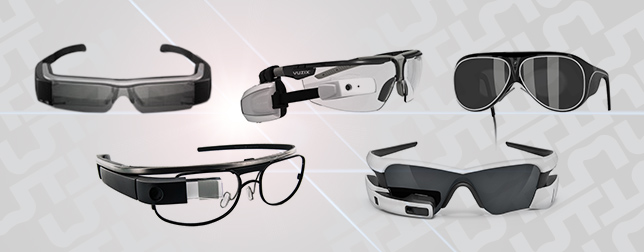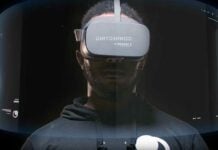Since the announcement of Google Glass back in 2012, there has been a huge hype over the face-worn computer. While it’s the most discussed of its type, Glass is surely not the only smart glasses in development and unlike Google a few other companies have already brought their smart glasses to the market. To give you an idea of what the industry is working on and what different kinds of approaches are available, we’re presenting you with some of the hottest smart glasses in this overview.
Google Glass
Google Glass has become the symbol for modern, head-mounted computer interface. Constantly featured at fashion shows and other cool events, Google has done a great job at marketing and geeks all over the world have fallen in love with Glass. From a technical point of view, Glass comes with a 640 *360 pixel screen that sits in the upper right corner of your field of vision. The screen presents notifications, contents from the web and also runs native apps often referred to as Glassware. Glass has a 5 MP camera, runs on a 1,2 Ghz dual core processor and has a built-in WiFi and Bluetooth connection. Google and the early users of its exploration program are currently testing the second generation of Glass, which yet has to be launched on the market. If you are looking to get one of these $1,500 beta devices, you need to be nominated by a Glass owner; however, you are also eligible for invitation if you subscribe to Google Play Music All Access. Google and other companies such as Rochester Optical are already offering subscription lenses for Glass, so people with impaired vision can now also use the head-mounted display. With many companies and developers already working on apps for Glass, Google has the potential to build a strong platform for head-mounted computers.
Vuzix M100
The M100 from Vuzix is one of the few smart glasses already available on the market. Similar to Glass, it contains a display mounted above the eye with a resolution of 432*240 pixels. This delivers a viewing experience comparable to a 4-inch mobile device screen seen at a distance of 14 inches. The M100 is powered by a 1 Ghz processor and is based on Android, which according to Vuzix makes it capable of running apps from the Google Play store. Compared to other solutions, Vuzix focuses much more on professional users that can benefit from the head-mounted computers in warehouses, hospitals or construction sites. Unlike devices that are designed to resemble regular glasses, the Vuzix M100 are worn either with a headband or a pair of safety glasses. The display is reversible and can be attached above either the left or the right eye. The M100 has a 5 MP camera and a microphone for voice commands and can be controlled by head movements and control buttons. It comes with 4 GB of memory, which is extendable to 32 GB with SD cards. The M100 is available on Vuzix’ website for $999.
Recon Jet
The Jet is the first smart glass especially designed for endurance athletes. Its manufacturer Recon is one of the pioneers in the field, with many years of experience in head-mounted displays designed for skiers and snowboarders and integrated into snow goggles. In contrast, the Jet is a heads-up display for cyclists or runners and presents live information about performance metrics such as speed, distance, elevation and gain. This display is attached to a pair of sports glasses with polarized lenses. It comes with an integrated GPS, and can be connected with sport sensors such as heart rate strap bands, power meters and cadence sensors via Ant+ or Bluetooth. When connected to an iPhone or Android device it also displays notifications for text messages, incoming calls and information from the web. The Jet runs on a dual core CPU and is equipped with a gyroscope, a magnetometer, an altimeter and a thermometer. An integrated microphone, speaker, an IR sensor for glaze detection and an optical touch pad allow for control when doing sports outside. The first production batch of the Jet will be available in a limited number for $599 in the spring of 2014.
GlassUp
Glass Up is an Italian startup working on stylish and discrete connected glasses that keep their users informed and in control of incoming notifications from their smartphones. Unlike other smart glasses, it does not simply place a tiny display in front of the user’s eye but projects information straight onto the right lens of a stylish pair of Italian designer glasses. The projection has a resolution of 320 x 240 pixels and positions the information right in the viewing field of the user, making it unnecessary to glance upwards such as with Glass and similar solutions. GlassUp is working on different versions of its connected glasses. The first version focuses on notifications and therefore comes without a camera or microphone. Future versions are planned for users in need of prescription glasses or who want a camera. The first generation of GlassUp is available for preorder; delivery is planned for September 14th.
Meta Pro
Meta is one of the leading developers in the field of modern augmented reality glasses. The startup, whose Chief Scientist is the pioneer of augmented reality Steve Mann, says it is working on the first “holographic interface“. Thus, the Meta Pro uses cameras to capture its surroundings and then processes the information in a pocket computer for object recognition and manipulation as well as for generating artificial objects. Two projectors built into the frame cast images with a resolution of 1280*720 pixels onto screens in front of both eyes, making up for a screen surface 15 times the size of Google Glass. This Iron-Man type of user interface allows for applications such as games, 3D modeling and much more. The Meta Pro is available for preorder for a hefty sum of $3,650 and is set to launch in September. A simpler edition is also planned for September; although it can’t keep up with the Meta Pro’s style, it comes for $667. The Pro is a mobile device that comes with a pocket PC that powers the glasses with an Intel i5 processor, whereas the developer edition relies on a standard PC to do the graphic processing.
Epson Moverio
Epson is already preparing to ship the second generation of its augmented reality glasses. The Moverio BT 200, successor of the BT 100, consists of a heads-up display and an Android based control unit that runs the software and stores the energy for up to six hours of continuous operation. The control unit has a touchpad and an SD card slot for memory extension. With built-in WiFi and Bluetooth, the Moverio connects to the web, displays videos, games and augmented reality applications, which all use the integrated camera. Many developers from the gaming industry as well as from the enterprise sector have already started developing apps for the Moverio, so at its launch, you can expect to find a fast-growing ecosystem. Epson’s smart glasses have an insert for subscription lenses and come with removable shades for sunlight protection. While the design has been greatly improved since the previous version, the BT 200 still is not the most fashionable glasses you can buy. Nevertheless, at a price of $699, it is a great entry into the world of augmented reality.
The Race For the Next Wearable Platform Is On
Aside from the products mentioned above, many other companies are also working on head-mounted displays for professionals and consumers. Telepathy‘s glasses resemble the devices from Google and Vuzix, while their focus lies more on the consumer side. Atheer Labs and Lumus are working on devices that compete with Meta and Epson. Even though it might still take a few months for the range of smart glasses available to broaden, the race for the next Wearable Technologies platform has already begun.




















